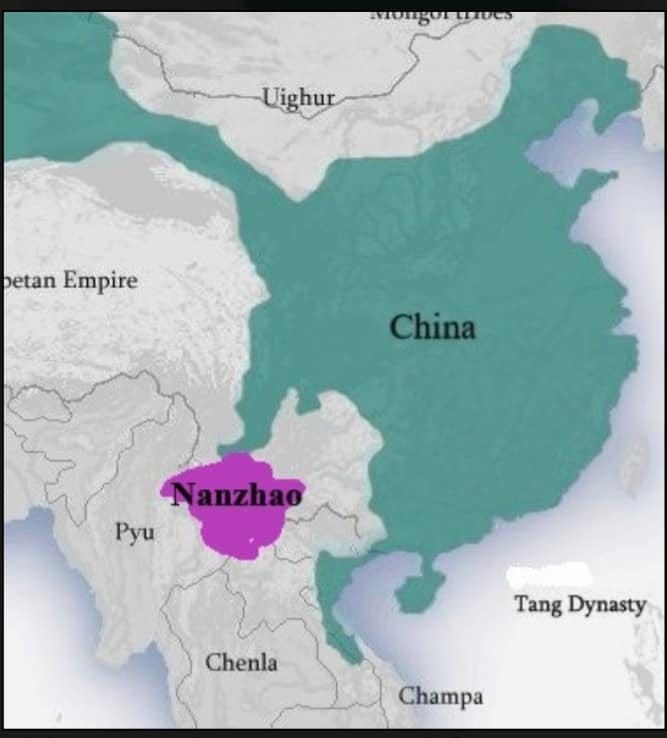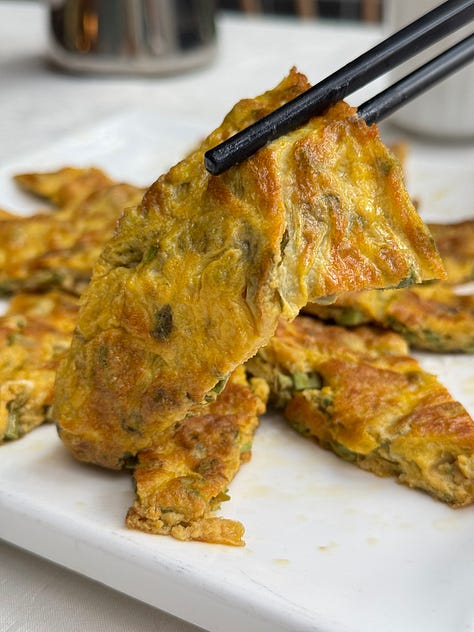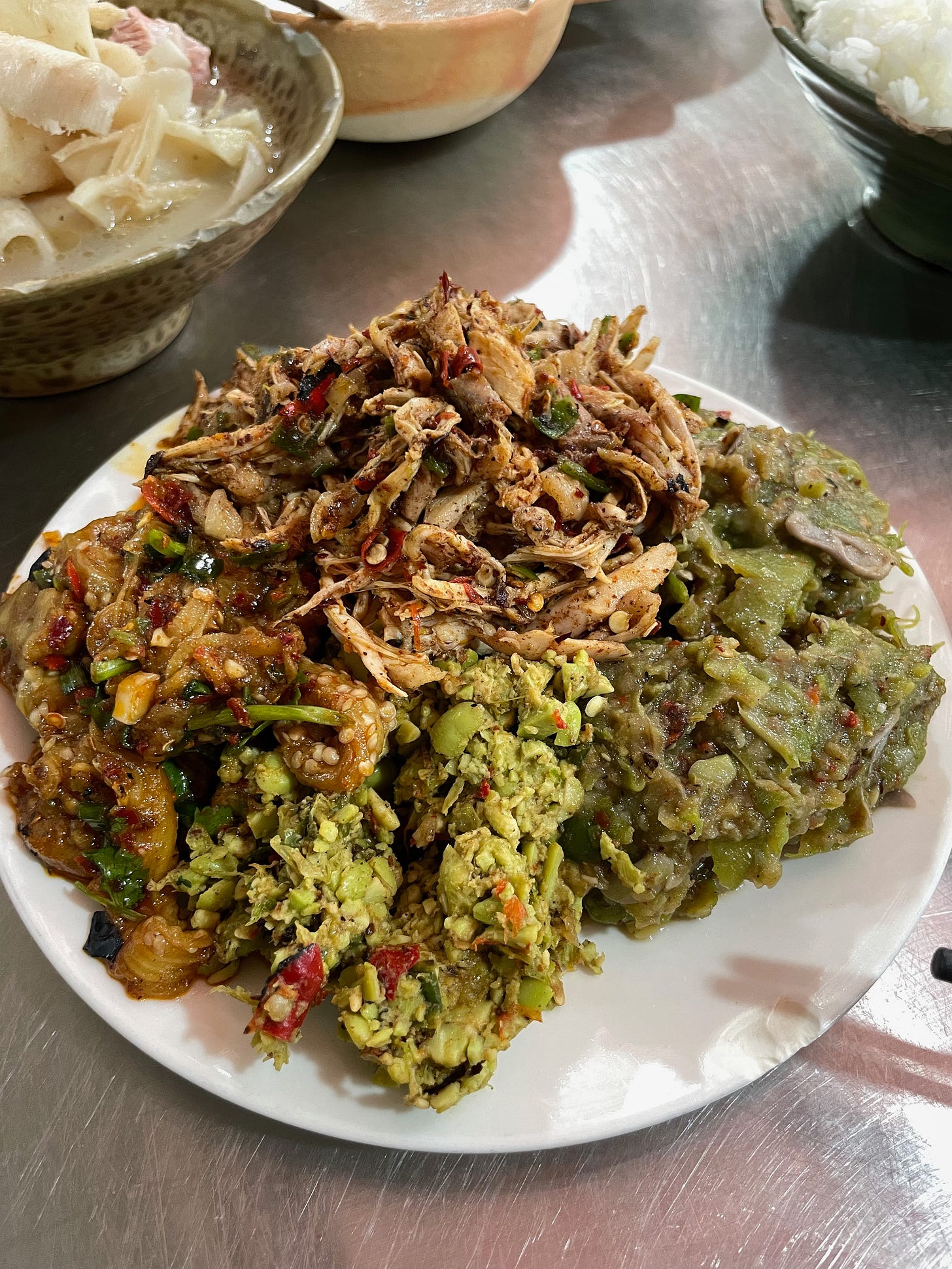Yi People's Pounded Chicken (舂鸡)
A spicy pounded chicken from E'shan, and our first dive into Yi cuisine
This is a chicken dish from the Yi people, from a small town outside of our new home in Yuxi, Yunnan.
The Yi people are one of the largest Chinese minority groups, and are indigenous to mountainous swaths around Sichuan, Guizhou, and Yunnan. If you went back far enough (emphasis on ‘far enough’), it was actually them that governed this region — ruling over a patchwork of ethnic groups that made up the Nanzhao Kingdom. In Chinese literature, the Kingdom’s captured the imagination of Kung Fu epics, occupying a similar place as ‘Timbuktu’ in the west: an ‘exotic faraway place’, evocative of the distance.
But the real Nanzhao was, nevertheless, well over a millennium ago. And as the Han began to wrest political control of the southwest, the Yi fractured — still controlling tributary chiefdoms in pockets, but mostly living as one among many in a vast, multi-ethnic empire.


The result of that fracture is a bewildering number of Yi subgroups that can be… difficult for the amateur to navigate. There’s the Nuosu and the Shansu, the Sani and the Axi, the Azhe and the Pula (among many others). Many defy categorization — there’s also closely related groups such as the Hani in Honghe, the Naxi in Lijiang, and (intriguingly) the Burmese in Myanmar.
So when we discuss Yi cuisine, it’s important that we be specific. This is a chicken dish from the Nisu subgroup that hail from the town of E’shan in Yunnan. If you went to Liangshan in South Sichuan (probably the epicenter of Yi culture today), their chicken would be quite different.
E’shan’s Pounded Chicken
Now historically, metal working arrived somewhat late to E’shan — together with the migration of the Han Chinese during the Ming Dynasty. And like a lot of places where metalware was a valuable import, the traditional food of the E’shan Nisu appears to have relied on pounding over knifework. This chicken is perhaps the most beloved, but at restaurants you can also find pounded eggplant, edamame, and broad beans:
But there’s also a culinary benefit of pounding in this sort of application: sort of akin to something like a Thai Som Tam, pounding the chicken can really do a bang up job incorporating the seasoning in with the ingredient itself — much better than simply dressing it. Further, often older chickens would be opted for this specific dish, the repeated pounding breaking up the muscle fibres of the comparatively tougher bird.
Flavor-wise, there’s a few different approaches. Some families lean heavily on chili oil, others include fresh or roasted chilis in their mix — but to a T all recipes will include this ingredient:



And that’s xiangchunzi (香椿子, left), the seeds of the Chinese Toon tree. The plant itself — sometimes translated the ‘beef and onion plant’ — can be found in pockets throughout China. It’s generally seasonal to the early Spring, and is a pretty exciting time because it’s… an awesome ingredient. It has a flavor that’s really quite difficult to describe, though I guess “herbaceous with a side of beef and onion” wouldn’t be the worst descriptor.
This dish uses the seeds, first time we’ve ever seen that move in all of our time cooking Chinese food. So definitely do trust us that no matter how awesome your local Asian supermarket is, you definitely are not going to be able to find this foundational seasoning.
“Uh… so okay I guess? So I’m just never going to be able to make this dish? Thanks for wasting everyone’s time…”
I promise that I’m not trying to be a dick here. This is a very tasty chicken dish, but we’re covering this because I do think it can be relevant to the average home cook in the west. And everyone likes a good shredded chicken, right?
So last time I was in the USA seeing parents, what I did was develop a recipe using (basically) western-supermarket available ingredients. That recipe is below — feel free to click through to it directly if you just want to make some chicken. But because I’m pretty sure this is the first time this dish has been discussed in the English language, we also felt a responsibility to go over properly how the dish would be made in Yunnan at first.
And again, do know that there’s some diversity here. But you’ll generally start with:
One chicken, preferably older, 1.5-1.8kg
and place that in cool water together with
~1 inch ginger, smashed
~1 sprig of scallion, tied in a knot
and get that up to a boil. Skim well. Lower the flame to medium low, cover, and cook for 90 minutes.
Remove the chicken and let dry, at least 30 minutes. Shred into pieces, as you would a shredded chicken (for the skin, I like to separate it cut it with a knife).
In a large mortar, pound
15g toon seeds
3g Sichuan peppercorns
2g White peppercorns
¾ tsp salt
¾ tsp chicken bouillon powder
¼ tsp MSG
until good and powdery. Then add
1.5 tbsp toasted chili flakes (煳辣椒, something like a Thai Prik Bon powder would work as a decent substitute)
and pound to mix. Then, over at the stove, get
¼ cup rapeseed oil (菜籽油)
up to smoking, and pour it in the mortar with the chilis and spices. Add the shredded chicken and mix well. Add
An additional 1 tbsp toasted chili flakes
2 green medium chili, sliced (optional)
1 red spicy chili, sliced (optional)
And pound until the chicken is broken up, the fresh chilis are broken down, and the flavor is absorbed (~5 minutes).
Adjusting to an American Supermarket
So by far the most problematic ingredient here is, obviously, the toon seeds. There’s going to be no direct substitute, but luckily it’s a secondary flavor in the dish itself – the most obvious tastes are (1) chili pepper and (2) Sichuan pepper.
The toon seeds mostly add complexity and depth. Our substitute was Dill Seed. While the toon seeds are a little… earthier? It hits similar notes, and the truly obsessive could perhaps add in a shaving of dried mushroom to compensate.
The next issue is going to be equipment. If you have an awesome, massive, southeast Asian style mortar at home… fantastic. Use it, but I think the average western kitchen would be lacking one?
If we were trying to make this dish with an old hen or something, lack of mortar would be a non-starter. But (ironically) lucky for us… most mass produced chicken in the west doesn’t get a ton of exercise, and the meat is much less snappy than you would find with a higher quality bird. What would take the Nisu a mortar and pestle can be broken down with just your hands (we’ll want some sort of gloves, at least something makeshift) and a touch of elbow grease.
Other swaps we made:
White pepper we subbed for Black pepper. My parents already had black pepper on hand, and at non-Asian supermarkets sometimes the white pepper quality can get dicey. Good black pepper is a better sub for good white pepper than shitty white pepper is (note: if you find your white pepper is ‘funky’, get a better source of white pepper).
For the toasted chili flakes, I lightly toasted Guajillo chilis and grinded my own, as we needed to grind up some seeds anyhow. I was originally going to use Cayenne pepper (perhaps mixed with gochugaru), but the supermarket near my parents had a nice dried chili section in the ‘international’ aisle. Feel free to get creative here – a mix of gochugaru (for color and fragrance), cayenne (for heat), and a little smoked paprika (for a bit of ‘toasted chili’ flavor) could also be nice, especially if you’ve got a lower heat tolerance.
The fresh chilis, meanwhile, were easy. I used two jalapenos and one habanero.
I cut the chicken bouillon powder, as at most western supermarkets seem to only have cubes (sometimes with lots of herbs). To compensate, I quadrupled the MSG and slightly upped the salt.
Lastly, I know that Sichuan pepper is usually only found in powder form in many supermarkets. But apparently I still had a box of Sichuan peppercorns from the last time I visited the USA… and I ended up opting for the peppercorns. Because Sichuan pepper is such a dominant flavor in the dish, I would suggest trying to use and grind whole peppercorns (very available online) if at all possible.
Recipe, Western Supermarket Version
In a pot with cool water, place
1.3 kg (~3 lbs) chicken thigh
~1 inch ginger, smashed
~1 sprig of scallion, tied in a knot
and get that up to a boil. Skim well. Lower the flame to medium low, cover, and cook for 60 minutes.
In the meantime, lightly toast
~25g Dried guajillo chilis
and blitz into a powder. We’ll need ~2.5 tbsp. Also grind:
8g dill seeds
3g Sichuan peppercorn
2g black pepper
and set aside.
Once the chicken is tender, remove and dry for 30 minutes. Shred, separating the chicken from the skin.
Mince the skin together with
2 fresh jalapeno
1 fresh habanero
and set aside.
In a large mixing bowl, mix the previously ground spices together with:
1 tsp salt
1 tsp MSG
1.5 tbsp ground guajillo
and heat up
¼ cup neutral oil, or peanut oil
until smoking. Pour over the ground spices and mix well. Add back the chicken, mixing and ‘smushing’ the meat into the spiced oil. Add the skin and chili mixture, and continue to mix until all is incorporated. Serve.





Toon tree (Toona sinensis) seeds are available from AnniesHeirloomSeeds dot com. Easy enough to grow in most of the USA,, and it's probably reliably winter hardy into USDA growing zone 6 -- https://planthardiness.ars.usda.gov/
or further north with winter protection.
This was really good! Rather than boiling it, I prepped the chicken w/ a recipe for rice cooker chicken rice since the ingredients overlapped pretty well. Turned out great, really efficient dinner